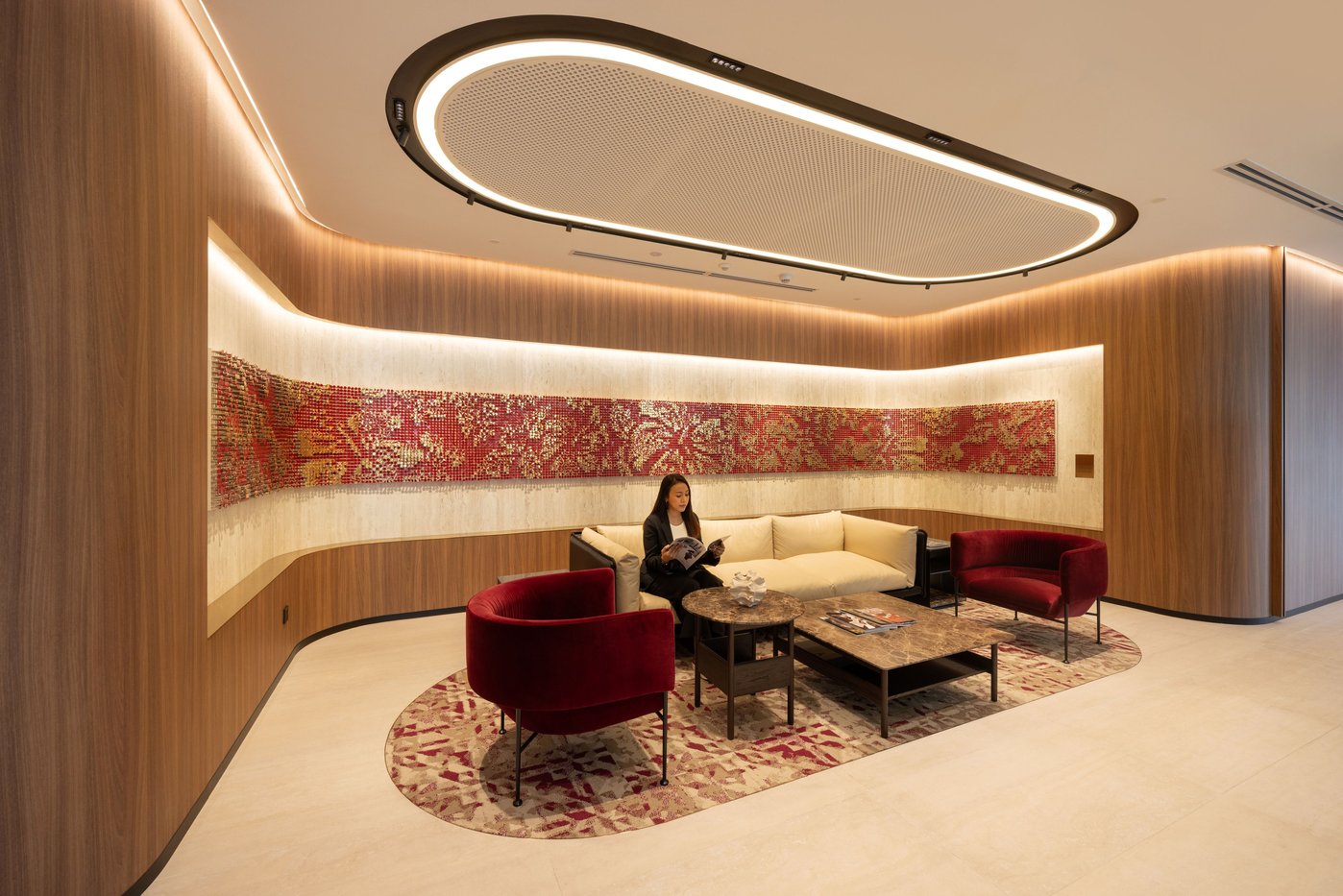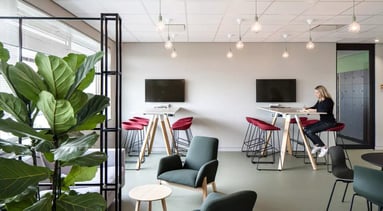Workplace Mental Fitness Volume. 2: Building Truly Inclusive Workplaces for Employees with Disabilities | Q&As with Leading Designers Eelaine Toh, Trupti Haryan, and Cheryl Martirez

As the global workforce becomes more diverse, our workplaces must evolve to reflect that diversity—not just in who we hire, but in how we design the environments they thrive in.
At Unispace, we believe that inclusivity isn't an afterthought—it's a foundation. While the conversation around workplace diversity has gained momentum, accessibility remains an area where design innovation can make a tangible, life-changing impact. For individuals with disabilities, the built environment often communicates more than words: it either welcomes—or excludes.
The Hidden Cost of Inaccessible Workplaces
Globally, over 1.3 billion people live with some form of disability, accounting for 16% of the population (World Health Organization, 2023). Among these, physical impairments—ranging from mobility challenges to chronic conditions—are among the most visible yet frequently overlooked in workplace design.
Inaccessibility has deep consequences. Studies have found that employees with disabilities are more likely to experience workplace discrimination, exclusion, and mental health challenges. For instance, in the U.S., workers with disabilities report higher levels of anxiety and depression, often driven by inaccessible facilities, social isolation, and lack of accommodations (U.S. Bureau of Labor Statistics, 2023).
In Singapore, a 2022 study by the Association of Women for Action and Research (AWARE) and the Disabled People’s Association revealed that 78% of persons with disabilities reported experiencing discrimination, a significantly higher rate compared to 50% among persons without disabilities. The Ministry of Manpower’s (2023) Fair Employment Practices Report also indicated a concerning rise in mental health-related discrimination, with 4.7% of employees reporting such experiences—up from 3.2% the year before.
In India, challenges persist despite increasing awareness. A report by the National Centre for Promotion of Employment for Disabled People (NCPEDP, 2022) highlighted that many persons with disabilities continue to face barriers during recruitment and advancement, largely due to inaccessible workplaces and social stigma. Similarly, Sarthak Educational Trust (2021) found that people with disabilities in urban India commonly encounter workplace exclusion, limited role options, and a lack of assistive infrastructure, all of which impact their mental health and professional growth.
Inclusive Design in Action
At Unispace, our designers are not only creators of space—they are advocates for equity. Across Asia, our teams are embedding accessible design solutions that go beyond regulatory checkboxes.
From adaptive furniture to wheelchair-friendly circulation paths, tactile wayfinding to acoustic zoning, inclusive design is reshaping the employee experience—especially for people with physical disabilities.
To explore how these principles are brought to life, we spoke to three designers across Unispace Asia who are championing accessible workplaces in their own way.

Q: What are some important accessibility considerations you include in projects?
A: Key accessibility features include integrating hearing aid-compatible systems and placing visual signage at both wheelchair and standing eye levels for maximum visibility. In compact areas, door swings open outward to enhance maneuverability for wheelchair users. Circulation paths are carefully planned to ensure smooth, unobstructed movement for all users.

Q: How do you collaborate with clients to ensure the needs of employees with physical disabilities are prioritized?
A: We work closely with clients to align with their inclusivity goals, often creating detailed accessibility packs that map the user journey for wheelchair users. These include guidance on furniture heights, signage placement, and hearing aid-compatible technologies—ensuring the environment is both functional and welcoming for everyone.
Q: Can you describe a space that reflects thoughtful inclusive design?
A: A bar counter with a lowered ledge is a great example of inclusive design. It comfortably accommodates wheelchair users without compromising visual appeal. Integrated charging points at this section also enhance usability and convenience for all users.

Lowered tables at the open space accommodate employees who use wheelchairs
Q: What challenges or learnings often arise during the project implementation phase?
A: Sourcing loose furniture that meets both global accessibility standards and the project’s design vision can be a key challenge. It requires in-depth research and close coordination with suppliers to ensure compliance without compromising aesthetics or functionality. This process highlights the importance of balancing design intent with practical and regulatory requirements, especially across regions with varying standards.

Q: What unique considerations do you incorporate to support physical accessibility in the Indian context?
A: Designs balance global accessibility standards with local cultural needs. Corridors and doorways are widened to support wheelchair users, and turning radii in restrooms and meeting rooms are optimized for easy navigation. Tactile flooring and high-contrast, bilingual signage with Braille support visually impaired users, while audible cues in elevators enhance wayfinding. Accessible toilets are provided on each floor and often separated by gender to respect cultural norms. Lever-style fixtures, grab bars, and emergency alarms are thoughtfully placed, and seating areas accommodate caregivers. Evacuation plans include accessible equipment, trained staff, and dual-mode (audio-visual) fire alarms.

Lowered tables at the cafe accommodate employees who use wheelchairs
Q: How do you ensure that workplace design maintains dignity and independence for employees with disabilities?
A: We avoid segregated areas by ensuring shared spaces like cafeterias and meeting rooms are equally accessible. Adjustable desks, barrier-free circulation, and accessible restrooms on every floor support independent movement. Assistive technologies in meeting rooms and inclusive hybrid tools enable active participation. Quiet zones with acoustic control cater to neurodivergent employees, while wayfinding is designed with Braille and local languages. Employees have the autonomy to choose their workspace, and confidential support channels—along with direct input from people with disabilities—help shape a respectful and inclusive environment.
Q: What role does technology or innovation play in improving accessibility in workplace design?
A: Technology enhances autonomy through voice-activated controls, touch-free systems, and screen-reader compatibility. Live captioning improves communication, while smart desks with ergonomic presets, IoT-enabled monitors, and adjustable lighting support diverse needs. Acoustic solutions increase comfort in shared spaces. Emergency systems use sound, light, and vibration alerts, and mobile apps enable users to discreetly request help or share feedback—driving continuous improvement through real-time data.

Acoustic solutions improved comfort for sensory sensitive employees in shared spaces
Q: How does a client’s vision shape your design direction, particularly around inclusion?
A: When a client prioritizes equity and belonging, the design moves beyond compliance toward universal design. This can lead to the inclusion of sensory-friendly spaces, gender-neutral restrooms, and multilingual signage. Tech-driven clients often emphasize integrating assistive technologies into the core infrastructure. Co-design sessions with employees ground the design in lived experience, while localization ensures cultural relevance—especially in regions like India. The result is equitable access across all areas and a workplace that supports long-term wellbeing for a diverse workforce.

Q: In dense urban environments like Hong Kong, what are some of the unique challenges or opportunities when it comes to designing accessible workplaces?
A: Space constraints and aging infrastructure make accessibility a real challenge in cities like Hong Kong. Retrofitting older buildings or integrating accessible features within tight footprints often adds complexity and cost. Yet, these environments also present opportunities—smart technologies, creative vertical circulation strategies, and universal design principles allow us to embed accessibility in seamless, efficient ways from the outset.

Phone booths, smart technologies and sunlight create welcoming environment for employees with neurodiversity
Q: How do you stay informed and inspired when incorporating accessibility features into spaces that may have limited physical flexibility?
A: I stay inspired by engaging with individuals who have lived experiences of disability, studying best practices, exploring urban case studies, and collaborating with accessibility experts. These insights help uncover creative, context-sensitive solutions—even in compact or inflexible environments.
Q: Can you share an example—professional or personal—where you witnessed the impact of inclusive design on someone’s sense of dignity or belonging?
A: While redesigning a community center for older adults in Hong Kong, we incorporated adjustable furniture, sensory-friendly zones, and accessible public areas—despite tight space and budget limitations. After the project, a wheelchair user shared that it was the first time they could participate fully and independently. That moment reinforced how thoughtful, inclusive design can restore dignity and foster a true sense of belonging.
Q: What advice would you give to emerging designers in Asia who want to advocate for more inclusive and accessible environments?
A: Learn deeply about accessibility standards, user diversity, and inclusive design principles. Even when it’s not mandated, make inclusion a core part of every project. Engage with people with disabilities, exchange ideas with peers, and find creative ways to make accessibility a standard practice—not an afterthought.

Designing for What Matters
Accessibility should never feel like an add-on. It should be seamlessly woven into the user experience—discreet yet powerful in impact. At Unispace, our mission is to craft workplaces where everyone, regardless of ability, feels seen, supported, and empowered to succeed.
As the future of work becomes more hybrid, digital, and human-centered, the way we design must keep pace. By embracing inclusive principles today, we can create a more equitable tomorrow—for our clients, our teams, and every individual who walks through the doors we design.
Reference:
Association of Women for Action and Research (AWARE) & Disabled People’s Association. (2022). Understanding the workplace experiences of persons with disabilities in Singapore. https://www.aware.org.sg/research/
Ministry of Manpower. (2023). Report on fair employment practices 2023. https://www.mom.gov.sg/
National Centre for Promotion of Employment for Disabled People (NCPEDP). (2022). Status of employment of persons with disabilities in India. https://www.ncpedp.org/
Sarthak Educational Trust. (2021). Inclusion at workplaces: Experiences of people with disabilities in urban India. https://www.sarthakindia.org/
U.S. Bureau of Labor Statistics. (2023). Persons with a disability: Labor force characteristics summary. https://www.bls.gov/news.release/disabl.nr0.htm
World Health Organization. (2023). Disability and health. https://www.who.int/news-room/fact-sheets/detail/disability-and-health


